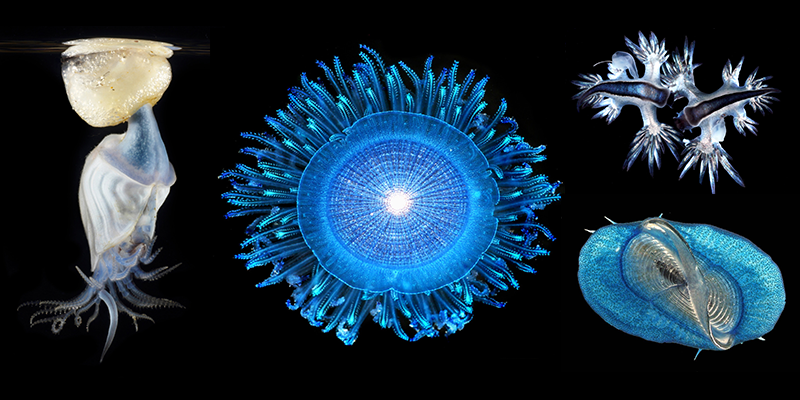Photos courtesy of Denis Riek from L : Bottom R – Bouy Barnicle, Porpita, Blue Sea Dragons, By-the-wind Sailor
GO-SEA Strives To Combine Community Observations With Scientific Monitoring To Help Scientists Better Understand Our Changing Ocean
UNC Asheville Assistant Professor of Biology Rebecca Helm is co-leading a global quest to map life on the ocean’s surface. With much of the earth’s oceans largely unexplored, Helm and a team of marine biologists have developed The Global Ocean Surface Ecosystem Alliance (GO-SEA), an effort to mobilize citizen scientists and volunteers to collect information across the ocean’s surface and along coastlines. Helm and her team developed this initiative intending to discover living islands of floating life. The project has earned recognition from NASA and has received two-year grant funding for a demonstration phase with the potential of implementation funding for additional three years.
“Around the world, citizen scientists are snapping photos and recording their findings of ocean life – they are mapping their own backyards,” says Helm. “Their individual contributions are puzzle pieces that create a greater map for scientists to read of the ocean surface.”
The Global Ocean Surface Ecosystem Alliance (GO-SEA) is a community of scientists and experts, including the Smithsonian Environmental Research Center, Ocean Voyages Institute, NASA NESDIS, and Plymouth Marine Laboratory, and marine enthusiasts coming together to observe and map what’s happening on the ocean’s surface. With the help of independent community submissions of sea life posted to iNaturalist, GO-SEA is creating a more extensive overview that combines those findings with access to satellite data and imaging, sea surface current data, and global monitoring. The result is a constantly evolving map that may help scientists better understand how human involvement like plastic consumption and oil spills can impact the ocean’s surface and its inhabitants.
Over 5,700 observations from over 850 contributors have been recorded by citizen scientists for GO-SEA. Among these recorded observations include a diverse assortment of neuston, organisms that live on the surface of the water, including Physalia, also commonly known as the Portuguese man-o-war; blue button jellies known as Porpita; Velella, also known by its romantic name By-the-wind Sailor; and the tiny, beautiful, but painful Glaucus, also known as the blue sea dragon. These findings provide a snapshot of the rich diversity of ocean life found floating among the waves.
“When people think of ocean exploration, they often think of coral reefs, the ocean floor, and the deep,” explains Helm. “And because most people dive down below the surface, passing through it and not spending a significant time there, this part of the sea is not well studied.” She continues, “However, there is a vast ecosystem of ocean life, including floating marine animals, jellyfish, flying fish, open ocean insects, slugs, and barnacles that all spend their existence on the sea’s surface! These ocean surface ecosystems are still wildly undocumented, but by activating a population of ocean-loving volunteers, we hope to gather a robust collection of information far and wide across the globe.”
According to the National Oceanic and Atmospheric Administration (NOAA), only 5 percent of our world ocean has been explored. With human actions encroaching further into unexplored marine environments, there is a significant risk of damaging biodiversity yet to be discovered. Mobilizing citizen marine scientists worldwide allows Helm and her team to collect real-time information and observations in an ever-developing platform.
The University of Hawaii is the lead principal investigator (PI) for this NASA-funded grant totaling over $370,000 in its first round of funding which includes Helm and UNC Asheville’s sub-award for the project titled “Observation of Neustonic Species with the Help of Citizen Scientists.” Over the next five years, Helm, and a handful of other sub-PIs, will continue research and development of the overarching project led by the University of Hawaii and funded by NASA. As co-PI, Helm’s project has the potential to receive upwards of $480,000 during the project timeline.
Helm and her team are excited about how word of this project has traveled, reaching citizen scientists from near and far around the globe, including a large demographic in Australia and New Zealand. For anyone interested in contributing, Helm says the project is open to “all beach and ocean-loving people who go to the water regularly!”
To learn more about GO-SEA and to sign up to become a contributing citizen scientist, visit https://goseascience.org/

Share
Permalink: